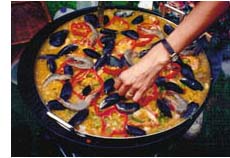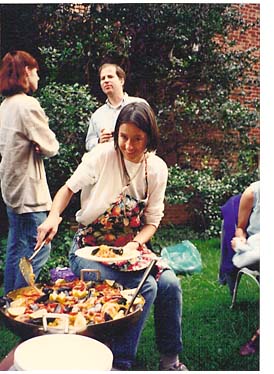Paella, or Spanish BBQ: A Classic Spanish Family Holiday Dish
- By Rebecca Taggart
- Reading Time: 5 mins.
Paella originates from my mother’s hometown of Valencia, Spain, and harkens back to the 13th century when the Moors brought rice to the Iberian Peninsula. Cooked in a shallow round metal pan first introduced by the Romans, paella is still traditionally reserved for family gatherings and special occasions.

I think of Paella Valenciana as Spain’s answer to American barbecue. When we visit my relatives in Madrid, the big paella pan always comes out. The whole multi-generational clan gathers while Javier, my cousin Blanca’s husband, does the honors outdoors over a large round portable gas burner, the equivalent of the American grill. Last summer, 26 of us sat down around the big table in the garden to drink red wine and devour delicious rice and seafood served directly from the pan. With such a large crowd, I had to fight for the crunchy rice stuck to the bottom of the pan (my favorite).
I can’t remember when I first tasted paella, but I do remember learning how to make it during a visit when I was eighteen years old. It was during Valencia’s spectacular Fallas festival. My oldest cousin Tesita invited me to join her and a group of friends at one of the paella contests that occur in the streets “round the clock” during the March festival.
Want fruit for your office?
Get your office a free sample TODAY!

We gathered in our designated spot and built up a wood fire. Once the coals were hot, we placed the paella pan over the coals, using bricks for support. We quickly added olive oil and browned the pre-diced onion and garlic, with a large pinch of saffron at the end, then the rice. Diced tomatoes followed, along with copious amounts of water. As the short-grained rice swelled, we added chunks of fresh monkfish and rings of calamari. With five minutes to go, in went the shrimp, including a few with the heads still attached, to be decoratively placed around the pan’s perimeter. Lastly, we arranged pre-washed mussels and clams in a pattern on top of the rice. As soon as they cooked and the shells opened wide, we removed the pan from the fire, decorated the paella with lemon wedges, and waited for the judges.
Our motley crew of recent college graduates must have done something right because we ended up with the second-place ribbon. Someone opened yet another bottle of red wine, and we ate our fill of paella to celebrate. I continue to make paella to this day following the same steps I learned then, using a 30” diameter pan to feed up to 14 hungry guests.
To cook your own traditional paella, I strongly recommend a Weber, or another round charcoal grill, roughly the same size as your pan, although a gas grill can also work. You can find smaller paella pans at most kitchen stores, but it can be more difficult to find the traditional larger pans. PaellaPans.com and Tienda.com are two online options. The small pans meant for two can be used on a stove-top, but cooking paella in the oven will not give a result anything like the BBQ version.
Although most of us associate paella with seafood, the most traditional version consists of chicken, rabbit or pork, fava, and lima beans, and escargot. The truth is you can combine almost any ingredients, from meat to seafood to vegetables, to make a good paella, using short-grain rice, onions, tomato, and saffron as the base. Feel free to mix and/or omit ingredients as fits your palette. The final consistency of the rice is similar to risotto, although the rice is not stirred after browning. The following is a family-friendly recipe for four, adapted from The Heritage of Spanish Cooking, by Alicia Rios and Lourdes March.
Want fruit for your office?
Get your office a free sample TODAY!
Recipes by Rebecca Taggart
Traditional Paella with Chicken and Beans
INGREDIENTS
- 1 cut-up chicken, with bones left in (with or without skin)
- ½ lb chorizo or chicken sausage, in ½–inch slices (optional)
- ⅔-cup olive oil
- 1 large onion, diced
- ⅓-lb large lima beans, fresh or frozen
- ½-lb Fava or green beans, trimmed and halved
- 1 tomato, cored and chopped
- 2 pinches saffron
- 2½ cups short-grained rice, preferably Arborio or Spanish
- 4½ cups water, plus more if needed to finish the rice
- 1 tsp salt, plus more to taste
- 1 lemon, sliced into wedges, for garnish
PREPARATION
- Heat the olive oil in an 18-inch paella pan and fry the chicken until brown.
- Add the diced onion, rice, lima and fava beans, and stir to coat the rice with oil, then let it brown a moment.
- Add tomato, salt, and 2½ cups water. Continue to add water as needed without allowing the rice to dry out.
- Once the rice begins to swell, add the green beans. Do not stir. Taste the rice – it is done when soft and expanded yet still a bit firm inside.
- Add salt as needed and garnish with lemon slices.
- To turn the above recipe into a chicken and seafood paella, add:
- ½–lb fresh calamari, cut into rings
- ½–lb shrimp, with some unpeeled (for flavor)
- 4-8 fresh mussels, in the shell
- Add the calamari and the shrimp at the same time as the green beans. Just 2-3 minutes before the rice is done, arrange the mussels around the edge of the pan.
- Remove paella from heat once the mussels have opened completely. (Discard any mussels that do not open.)
Serves 6. Prep time, 30 minutes; cook time, 1 hour.
Want farm-fresh fruit?
We've got you covered.Rebecca’s Winning Seafood Paella
This recipe won the 2nd-place ribbon at the Fallas festival in Valencia described above.
INGREDIENTS
- ½ lb monkfish or other white fish, cubed into 1–inch pieces
- ½ lb calamari, chopped into rings
- ½ lb shrimp, preferably with shells intact
- 4-6 shrimp, with heads and shells intact
- 1 lb fresh mussels, with scrubbed shells
- 1 large onion, diced
- 1 large clove garlic, diced
- 1 large tomato, cored and chopped
- ⅓-cup olive oil
- 2 pinches saffron
- 2½ cups short-grained rice, preferably Arborio or Spanish
- 5-6 cups seafood or chicken broth (water is ok but provides less flavor)
- salt to taste
- 2 lemons, cut into quarters for garnish
Preparation
- Use an 18-inch paella pan on a BBQ grill or gas burner (high heat).
- Heat oil in the pan and sauté the onion and garlic for 3 minutes.
- Add the rice and stir, slightly browning the rice, then add the monkfish, tomato, and saffron.
- Pour in the broth, and then stir in calamari and most of the shrimp, reserving the ones with the heads on and four headless ones. Stir once and taste for salt, then allow to simmer until rice is almost done.
- Place remaining shrimp in a pattern on top of the rice. Add some water if the rice is not producing steam.
- Place mussels decoratively around the pan’s edge.
- Once shrimp are pink and the mussels have opened, remove from heat and garnish with lemon quarters. Serve hot.
Serves 4. rep time, 30 minutes; cook time, 1 hour.
Cook’s note: You can double or quadruple the recipe for larger parties, but you will need a larger pan.
Get tips for your office
Be an office hero!
Rebecca Taggart is a San Francisco-based yoga instructor.


